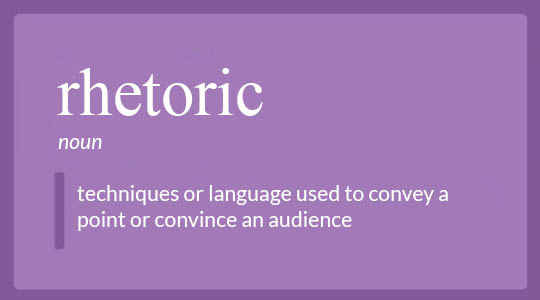Rhetorical Terms You NEED to Know About

In rhetoric, a rhetorical device, persuasive device, or stylistic device is a technique that an author or speaker uses to convey to the listener or reader a meaning with the goal of persuading them towards considering a topic from a perspective, using language designed to encourage or provoke an emotional display of a given perspective or action. Rhetorical devices evoke an emotional response in the audience through the use of language, but that is not their primary purpose. Rather, by doing so, they seek to take a position or argument more compelling than it would otherwise be (Wikipedia).
Argument mapping: refers to the ways of graphically depicting an argument’s main claim, sub‐claims, and support. In effect, it highlights the structure of the argument. Arrangement: the canon that deals with principles for organizing discourse.
Audience: the person or persons who receive the communication, especially those toward whom the message is directed (intended audience).
Backing: refers to the credentials that authorize the warrant. Toulmin states that backing tries to establish “[w]hy, in general, this warrant should be accepted as having authority” (Uses of Argument, 95). When the warrant is questioned or likely to be questioned by the audience, the rhetor needs to certify the warrant.
Claim: refers to an arguable proposition or a conclusion whose merit must be established.
Communication: the exchange of information from one person or persons to another person or persons.
Context: the conditions surrounding the communication; it can refer to the immediate circumstance or the larger cultural and historical circumstances or both.
Culture: shared beliefs, values, and characteristics of a group.
Data: refers to the reasons for the claim, which might consist of facts, explanations, illustrations, testimony, case studies, and other evidence. It provides the foundation for the claim.
Deductive logic: uses syllogistic reasoning to conclude.
Enthymeme: a syllogism that omits one of the premises or the conclusion with the expectation that it will be filled in by the audience.
Ethos: the means of persuasion affected through the audience’s perception of the rhetor’s character and traits. Ethos established within the text itself is called invented ethos; ethos established outside of the text before the message is called situated ethos.
Fallacy: false reasoning (e.g., bandwagon, red herring, ad hominem, begging the question).
Feminism: From Oxford English Dictionary (OED): 3. Advocacy of equality of the sexes and the establishment of the political, social, and economic rights of the female sex; the movement associated with this (see note below). Cf. womanism n., women’s liberation n., feminism n.
The rights for women first became prominent during the French and American revolutions in the late 18th century, with regard especially to property rights, the marriage relationship, and the right to vote. In Britain, it was not until the emergence of the suffragette movement in the late 19th cent. that there was significant political change. A ‘second wave of feminism arose in the 1960s, concerned especially with economic and social discrimination, with an emphasis on unity and sisterhood. A more diverse ‘third wave’ is sometimes considered to have arisen in the 1980s and 1990s, as a reaction against the perceived lack of focus on class and race issues in earlier movements.
Feminist: From OED: A. adj. Of, relating to, or advocating the rights and equality of women. Cf. FEMINISM n. 3. B. n. An advocate or supporter of the rights and equality of women.
Formal logic: reasoning based on strict use of categorical syllogism.
Gender: From OED: 3a. gen. Males or females are viewed as a group; = SEX n.1 1. Also: the property or fact of belonging to one of these groups. b. Psychol. and Social. (Orig. The U.S.). The state of being male or female as expressed by social or cultural distinctions and differences, rather than biological ones; the collective attributes or traits associated with a particular sex, or determined as a result of one’s sex. Also: a (male or female) group is characterized in this way.
Genre: a means of categorizing texts according to shared attributes or features. Examples of popular genres include speech, letter, email, term paper, editorial, short story, poetry, a five‐act play. Genres may be described in broad terms (e.g., the novel) or specific ones (e.g., the detective novel, the bildungsroman, Gothic novel, historical novel, pulp fiction, etc.).
Informal logic: sometimes called practical reasoning. The logic is used outside a formal setting.
Invention: the rhetorical canon that deals with generating the discourse.
Kairos: refers to the opportune time and place for an argument to be made. Kairos doesn’t ensure that the case will succeed, but “right timing” increases its likelihood of success.
Logos: according to Aristotle, one of the three means of persuading an audience. Logos refer to practical reasoning or informal logic, not formal logic, whose forms, according to Aristotle, were ill‐suited for reasoning about human affairs. Logos work instead in the realm of the probable or contingent through induction, rhetorical syllogisms, enthymemes, and examples.
Outline: a description of or plan for a text that lists the key points.
Pathos: the means of persuasion through the audience (e.g., their disposition, emotions, etc.).
Practical Reasoning: informal logic is used to arrive at a decision.
Premise: an assertion or proposition that forms the basis for any inference or conclusion.
Proofs: the means of persuasion (per Aristotle), i.e., ethos, logos, pathos.
Qualifier: refers to words or phrases that state the “force” of the speaker/ writer’s degree of certainty or “force” about the claim, including “certainly,” “probably,”
“possible,” “impossible,” and “necessarily.”
Rational: something that is based on or by reason and logic.
Reason: a statement that explains or supports the claim.
Rebuttal: refers to statements acknowledging restrictions that may legitimately be applied to the claim. Also, an exception to a claim.
Refutation: arguments pitched against the opposing point.
Rhetor: the person creating the discourse, variously referred to as the orator or speaker, writer, author, artist, etc., depending upon the medium of communication. The term can be used in singular or plural forms.
Rhetorical act: an act intended to influence another person or persons. Rhetorical acts come in many forms, e.g., a spoken or written text, a protest march, a seductive dance.
Rhetorical situation: refers to the circumstances of and participants in a
communicative act: the rhetor (i.e., the speaker or writer), the audience (i.e., the listener or reader), the issue, the context.
The Rhetorical Triangle: graphical representation of the components of a rhetorical situation.
Rhetorician: refers to a person who articulates rhetorical principles, usually by inducing principles from effective and ineffective communication.
Scheme: one of two major categories of figurative language. A scheme describes a pattern of words or structure that deviates from normal usage.
Sound: the way to describe a syllogism that is valid and whose premises are true.
Statistics: information expressed in numerical form. Sometimes referred to as quantitative data.
Support: reasons, evidence, explanation, illustration, anecdote, charts, figures, etc., to validate or prove a claim.
Syllogism: a logical form in which two premises are stated that lead to a conclusion that necessarily follows from the premises. It is a form of deductive logic.
Text: any discursive act, no matter the form.
Three proofs: according to Aristotle, the three means of persuading an audience: ethos, logos, and pathos.
Toulmin Model: a model for understanding the nature of argumentation as it exists in the world by describing how humans understand and reason. Developed by Stephen Toulmin, it allows us to see how simple and advanced claims are supported. That is, how claims are “justified” through explicit and implicit means. In turn, this analysis allows us to evaluate how strong or weak an argument is.
Trope: One of two major categories of figurative language left a deviation in the usual meaning of a word. The most common trope is a metaphor, and common examples of metaphor include “my love is a rose,” “all the world’s a stage,” “he’s a pig,” and “she has a fire in her belly.” Another common trope is a simile, a form which uses “like” or “as” to draw a comparison, e.g., “Her house is like Grand Central Station,” “you are as stubborn as a mule,” and “she’s like a bull in a china shop.”
Validity: indicates that the form of the reasoning is sound, thus guaranteeing that if the premises are true, the conclusion is true.
Values: principles or ideas that are used as standards for judgment, e.g., good/bad, right/wrong, effective/ineffective, useful/useless.
Warrants: refers to the statement authorizing movement from the data to the claim (i.e., the warrant explains the relevance of the data to the claim).
Read more articles on English Literature here.
About two and half years too old to be good at technology, but a bit of a self-professed book-nerd! That is exactly how I’ll describe myself. With an undying passion for reading and writing, I’ve landed in RangeInn as a Lifestyle Author. Yeah, that’s my new gig and I’m super excited to be part of the team. My articles are mostly about pop culture, celebrity gossip, entertainment, fashion & beauty, personality & spirituality, food, life hacks, books, movies and basically anything & everything that piques my interest.
Want me to write about something? Leave me a comment to connect with me. I’d love to hear from you!








